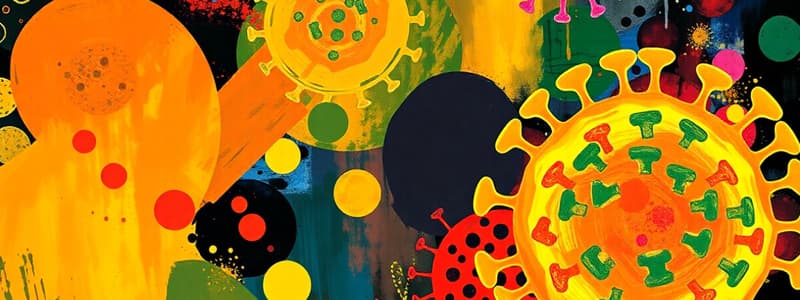Podcast
Questions and Answers
What is a key characteristic that differentiates archaea from bacteria?
What is a key characteristic that differentiates archaea from bacteria?
- Archaea are multicellular organisms.
- Archaea have distinct biochemical compositions. (correct)
- Archaea are always found in extreme environments.
- Archaea possess a nucleus.
Which form of energy metabolism involves the use of inorganic compounds?
Which form of energy metabolism involves the use of inorganic compounds?
- Phototrophs
- Lithotrophs (correct)
- Autotrophs
- Organotrophs
What is the main advantage of bacteria reproducing through binary fission?
What is the main advantage of bacteria reproducing through binary fission?
- It is a complex process.
- It requires sexual reproduction.
- It enables rapid population growth. (correct)
- It allows for genetic diversity.
How are bacterial shapes classified when they are in chains?
How are bacterial shapes classified when they are in chains?
Which type of membrane protein is specifically mentioned for transporting glucose molecules?
Which type of membrane protein is specifically mentioned for transporting glucose molecules?
What is the significance of peptidoglycan in bacteria?
What is the significance of peptidoglycan in bacteria?
Which characteristic of the cell membrane allows for selective permeability?
Which characteristic of the cell membrane allows for selective permeability?
Which components are predominantly found in the hydrophilic part of phospholipids?
Which components are predominantly found in the hydrophilic part of phospholipids?
Flashcards are hidden until you start studying
Study Notes
The Lytic Cycle
- The virus attaches to the host cell and injects its genetic material
- The viral genes are expressed, using host cell enzymes to create viral proteins
- New viral particles are assembled
- The host cell lyses (breaks open), releasing the new viral particles to infect more cells
The Lysogenic Cycle
- The virus injects its genetic material into the host cell
- The viral genes integrate into the host cell’s genome, becoming latent
- The viral genes are copied along with the host cell's DNA during reproduction, and spread through the infected cell's descendants, remaining inactive
- The virus may later enter the lytic cycle, due to certain environmental factors or chemical triggers
Requirements for Life
- Order: Organized structures
- Sensitivity/Response to Stimuli
- Reproduction
- Growth and Development
- Homeostasis (Maintaining a stable internal environment)
- Energy Processing
- Adaption/Evolution
Archaea
- Single celled microorganisms
- Possess unique biochemistry and genetic makeup compared to bacteria and eukaryotes
- Discovered in extreme environments like hot springs and salty lakes but can be found in more common environments
- Not restricted to extreme environments, as they are abundant in oceans, soils, in and on animals
Prokaryotes
- They are single-celled organisms that lack a nucleus or other membrane-bound organelles
- Two domains: Bacteria and Archaea
Energy Metabolism
- Phototrophs: Energy is derived from the sun (Photosynthesis evolved in bacteria)
- Lithotrophs: Energy is derived from inorganic compounds (example: metal ions)
- Organotrophs: Energy is derived from organic compounds (Organic compounds contain carbon)
Carbon Metabolism
- Autotrophs: Use inorganic carbon (CO2)
- Heterotrophs: Use organic carbon sources
- Inorganic means from non-living as opposed to organic which means from living or once living
Reproduction
- Bacteria and Archaea reproduce asexually through binary fission
Binary fission
- The cell grows in size
- The DNA replicates
- The cell divides into two identical daughter cells
Exchange of Genetic Information
- Transformation: Bacteria take up DNA from their environment
- Transduction: DNA is transferred from one bacteriumto another by a virus
- Conjugation: DNA is transferred directly from one bacterium to another through a pilus
Bacterial Classification
- Shapes:
- Spherical: Cocci
- Rod-shaped: Bacilli
- Spiral or corkscrew-shaped: Spirilla
- Configurations:
- Chains: “strepto-“ (e.g., streptococcus)
- Clumps: “staphylo-“ (e.g., staphylococcus)
- Gram Stain: Based on the amount of peptidoglycan present in the cell wall.
- Gram-positive bacteria: They have a thick peptidoglycan layer, stain purple
- Gram-negative bacteria: They have a thin peptidoglycan layer, stain pink
The Cell Membrane
- All life requires a body, which a cell membrane provides.
- Functions:
- Encloses the cell
- Regulates the passage of molecules in and out of the cell
- Maintains the cell's internal environment
- Provides a surface for attachment of proteins and other molecules
- Enables communication between the cell and its environment
- Unlike prokaryotes, eukaryotic cells also possess internal membranes that encase their organelles
Selective Permeability (Semipermeable Membranes)
- Only allows certain molecules or ions to pass through
- Some small molecules can freely pass through the membrane while others require specific transport proteins
Phospholipids
- The primary component of the cell membranes
- A phosphate head and two fatty acid chain tails
Phosphate Head
- Hydrophilic (water loving)
- Polar
- Water soluble
Fatty Acid Tails
- Hydrophobic (water repelling)
- Non-polar
- Water insoluble
Membrane Proteins
- Proteins are also found in the cell membrane.
- Carry out many different functions:
- Transport of molecules in and out of the cell
- Cell signaling
- Enzymatic activity
- Cell-cell recognition
- Structural support
- Example: Proteins to transport glucose molecules in or out of the cell
Endosymbiotic Theory: Evidence
- Mitochondria and chloroplasts are the same size as bacteria
- Mitochondria and chloroplasts have their own DNA
- Mitochondria and chloroplasts divide independently of the cell
Studying That Suits You
Use AI to generate personalized quizzes and flashcards to suit your learning preferences.




